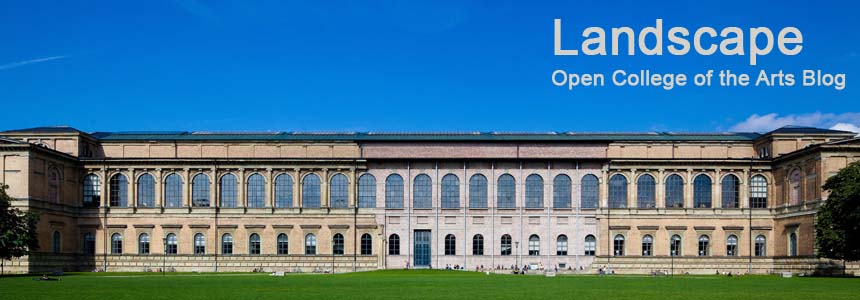As the old saying goes it never rains but it pours. In a post a few weeks ago I lamented that I did not spend enough time looking at other photographers work, well in the past two weeks I have now been to 3 major exhibitions and seen a wide variety of stunning work. This weekend, though, was the strange one. At MOMA and the ICP the photography on display was both historically important and frequently aesthetically beautiful, but could always be easily described as photography. The Thomas Ruff exhibit at the Haus der Kunst was something else entirely. Although I am sure that Ruff would agree that he is a photographer, I think a better description would be "Digital Artist Working in the Medium of Photography". This exhibit presented photography in entirely new ways, some wonderful, others banal, even shocking.
Thomas Ruff is yet another graduate of the Dusseldorf school and student of the Bechers, a group of photographers that seem to be becoming central to my study of photography. Living in Germany, these are the superstars that get the wall space in the local galleries. Ruff takes yet another direction in his work, but once again set alongside the work of Struth, Gursky and Hofer, as well as that of the Bechers, certain traits are all too familiar. There is a visible detachment from reality in much of the work, early photographs in particular are very devoid of emotion, they are stark records of the past. And, of course, the sheer size of most of the photographs on display, I can only guess that someone in Dusseldorf was on very good terms with an industrial printer.
However, Ruff has clearly taken the medium of photography further and in more different directions than his contemporaries. This exhibit was divided into about a dozen separately themed rooms covering his work from 1978 through to the present day. Whilst Ruff is clearly a talented photographer, it is what he does to photographs that clearly marks his work apart. On first entering the exhibit the first room is dominated by simply huge photographs showing details of the Martian landscape, clearly taken from orbit. Ruff has appropriated these freely available NASA images and turned them into a mysterious art form. He has taken a series of planar B&W images, then added perspective and colour to produce a sense of a topographical landscape.
This theme of taking a pre-existing photograph and processing in new and strange ways is a hallmark of Ruff's work. One room was filled with strongly pornographic images downloaded from the web and then softened in software until the structure of the images is virtually obscured, maybe a comment on the overuse of such images. In any case a special warning was preserved for this room, although it was visible from all the rooms around it. I get the idea, but still think it is tacky. A far more impressive use of this technology was in his series of jpegs of often famous sites or iconic images. Each was broken down into square blocks of pixels, close up impossible to see as anything other than an abstraction, but changing as you moved further away. The gallery was large and it was possible to get up to 100 feet from some of the images at which point they looked normal. This I think was a fascinating study of how we see images and convert chaos into information. It was also a good antidote to the crowd currently grumbling that the new Canon has only 22MP, not 38 like the new Nikon. In these photos the Pixels were half a centimeter across, but still the images were wonderful.
The other aspect of his work that I came to see were the portraits, photographs that I most readily associate with Ruff:
Again they were presented at monumental size. Asking his subjects to present themselves without any emotion, these are unusual portraits that say more about the structure of a face than the human it occupies. I think he succeeded in his goal of making a portrait that spoke as a photograph rather than as a person. He believes that a photograph is simply a surface that it is not a capture of a person, this neutral expression reinforces that philosophy.
Throughout the exhibit the sense was of an artist looking for ways to project his own personality and way of seeing through the medium of the modern photograph, irrespective of where the photograph originated. Each room expressed this feeling in different ways. I can quite honestly say that I did not particularly like much of what I saw, I was impressed but not moved. However, more than any other exhibition I have been to this one has opened my eyes to the possibilities of photography and the fact that it is not the finger on the shutter that matters it is the mind behind the final concept that defines the ultimate success or failure of the work as a piece of art.



No comments:
Post a Comment